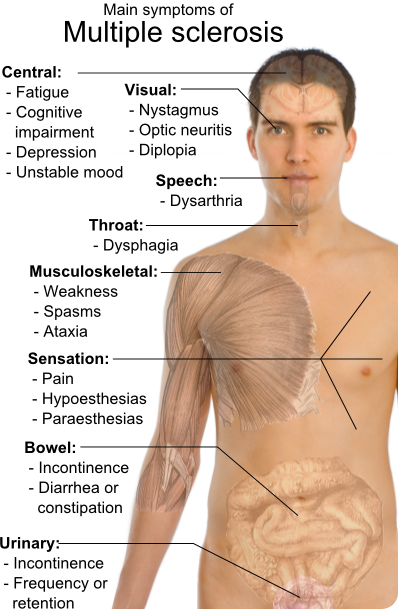Multiple Sclerosis (MS)
Multiple sclerosis (MS) is a nervous system disease that affects your brain and spinal cord. It damages the myelin sheath, the material that surrounds and protects your nerve cells. This damage slows down or blocks messages between your brain and your body, leading to the symptom of multiple sclerosis. They can include;
- Visual disturbances
- Muscle weakness
- Trouble with coordination and balance
- Sensations such as numbness, prickling, or “pins and needles”
- Thinking and memory problems
Today, several therapies are available that can ameliorate the symptoms of multiple sclerosis and, in some cases, slow disease progression. These treatments include the beta interferons (Betaseron®, Rebif®, Avonex®), and copolymer 1 (Copaxone®, also called glatiramer acetate), a mixture of peptide fragments. The NIH supported the research that led to the development and approval of Avonex® and funded the basic research that led to the development of Copaxone®. For severe forms of multiple sclerosis of relapsing remitting and secondary progressive multiple sclerosis, the FDA approved mitoxantrone (Novantrone®), an immunosuppressant. Most recently, the FDA approved Fingolimod (trade name Gilenya®) the first oral medication. Additionally there is natalizumab (Tysabri®), an antibody-based therapy that represents a new class of immunomodulatory agents, for a restricted population of patients with multiple sclerosis.
No one knows what causes multiple sclerosis. It may be an autoimmune disease, which happens when your body attacks itself. Multiple sclerosis affects woman more than men. Most people experience their first symptoms between the ages of 20 and 40; the initial symptom of multiple sclerosis is often blurred or double vision, red-green color distortion, or even blindness in one eye. Most multiple sclerosis patients experience muscle weakness in their extremities and difficulty with coordination and balance. These symptoms may be severe enough to impair walking or even standing. In the worst cases, multiple sclerosis can produce partial or complete paralysis. Most people with multiple sclerosis also exhibit paresthesias, transitory abnormal sensory feelings such as numbness, prickling, or “pins and needles” sensations. Some may also experience pain. Speech impediments, tremors, and dizziness are other frequent complaints. Occasionally, people with multiple sclerosis have hearing loss. Approximately half of all people with multiple sclerosis experience cognitive impairments such as difficulties with concentration, attention, memory, and poor judgment, but such symptoms are usually mild and are frequently overlooked. Depression is another common feature of multiple sclerosis.

Multiple sclerosis was first recognized as a disorder in the late nineteenth century, but it wasn’t until the nineteen sixties that researchers began to understand some of the disease processes that cause symptoms and long-term disability in multiple sclerosis. These processes seemed to involve inflammation and the loss of myelin, a protective covering around nerve fibers. The first standard guidelines for the diagnosis of multiple sclerosis and a disability rating scale were also established in the nineteen sixties, setting the stage for controlled research to test new therapies. In the late sixties, the first controlled clinical trials for multiple sclerosis therapy showed that treatment with adrenocorticotropic hormone speeded recovery from an attack. While this therapy helped to reduce inflammation during the acute symptoms of an attack, it did not slow the progression of multiple sclerosis.
Today, multiple sclerosis is recognized as a chronic, inflammatory, demyelinating autoimmune disease of the central nervous system (CNS). The damage to the myelin covering and to the underlying nerve cell fibers leads to slowed or blocked transmission of signals, which results in reduced or lost functions. Improved imaging techniques show that damage to nerve fibers can happen even at very early stages of the disease.
There are a number of myths about multiple sclerosis that are not based in research. First, multiple sclerosis is not contagious. Second, contact with heavy metals can cause damage to the nerves but there is no evidence of heavy metals or mercury from amalgam in dental fillings being linked with multiple sclerosis. Third, a number of viruses have been and are under study in relationship with multiple sclerosis. However, no virus has been found to cause multiple sclerosis.

